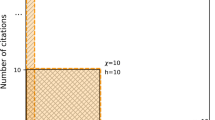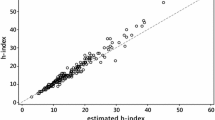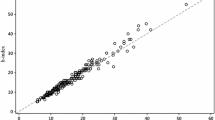Abstract
In a general framework, given a set of articles and their received citations (time periods of publication or citation are not important here) one can define the impact factor (IF) as the total number of received citations divided by the total number of publications (articles). The uncitedness factor (UF) is defined as the fraction of the articles that received no citations.
It is intuitively clear that IF should be a decreasing function of UF. This is confirmed by the results in [van Leeuwen & Moed, 2005] but all the given examples show a typical shape, seldom seen in informetrics: a horizontal S-shape (first convex then concave).
Adopting a simple model for the publication-citation relation, we prove this horizontal S-shape in this paper, showing that such a general functional relationship can be generally explained.
Similar content being viewed by others
References
Burrell, Q. L. (2007), Hirsch’s h-index: a stochastic model. Journal of Informetrics, 1(1): 16–25.
Egghe, L. (2005), Power Laws in the Information Production Process: Lotkaian Informetrics. Elsevier, Oxford, UK.
Frandsen, T. F., Rousseau, R. (2005), Article impact calculated over arbitrary periods. Journal of the American Society for Information Science and Technology, 56(1): 58–62.
Garfield, E. (1955), Citation indexes to science: A new dimension in documentation through the association of ideas. Science, 122: 108–111. Reprinted in: Essays of an Information Scientist, 6: 468–471, 1983. ISI Press, Philadelphia, USA.
Garfield, E. (2001), Recollections of Irving H. Sher 1924–1996: Polymath/Information Scientist Extraordinaire. Journal of the American Society for Information Science and Technology, 52(14): 1197–1202.
Ingwersen, P., Larsen, B., Rousseau, R., Russell, J. (2001), The publication-citation matrix and its derived quantities. Chinese Science Bulletin, 46(6): 524–528.
Redner, S. (2005), Citation statistics from 110 years of Physical Review. Physics Today, 58(6): 49–54.
Rousseau, R. (1997), Sitations: an exploratory study. Cybermetrics, 1(1) paper 1. http://www.cindoc.csic.es/cybermetrics/articles/vlilp1.html
Van Leeuwen, T. N., Moed, H. F. (2005) Characteristics of journal impact factors: the effects of uncitedness and citation distribution on the understanding of journal impact factors. Scientometrics, 63(2): 357–371.
Author information
Authors and Affiliations
Corresponding author
Rights and permissions
About this article
Cite this article
Egghe, L. The mathematical relation between the impact factor and the uncitedness factor. Scientometrics 76, 117–123 (2008). https://doi.org/10.1007/s11192-007-1902-x
Received:
Published:
Issue Date:
DOI: https://doi.org/10.1007/s11192-007-1902-x




